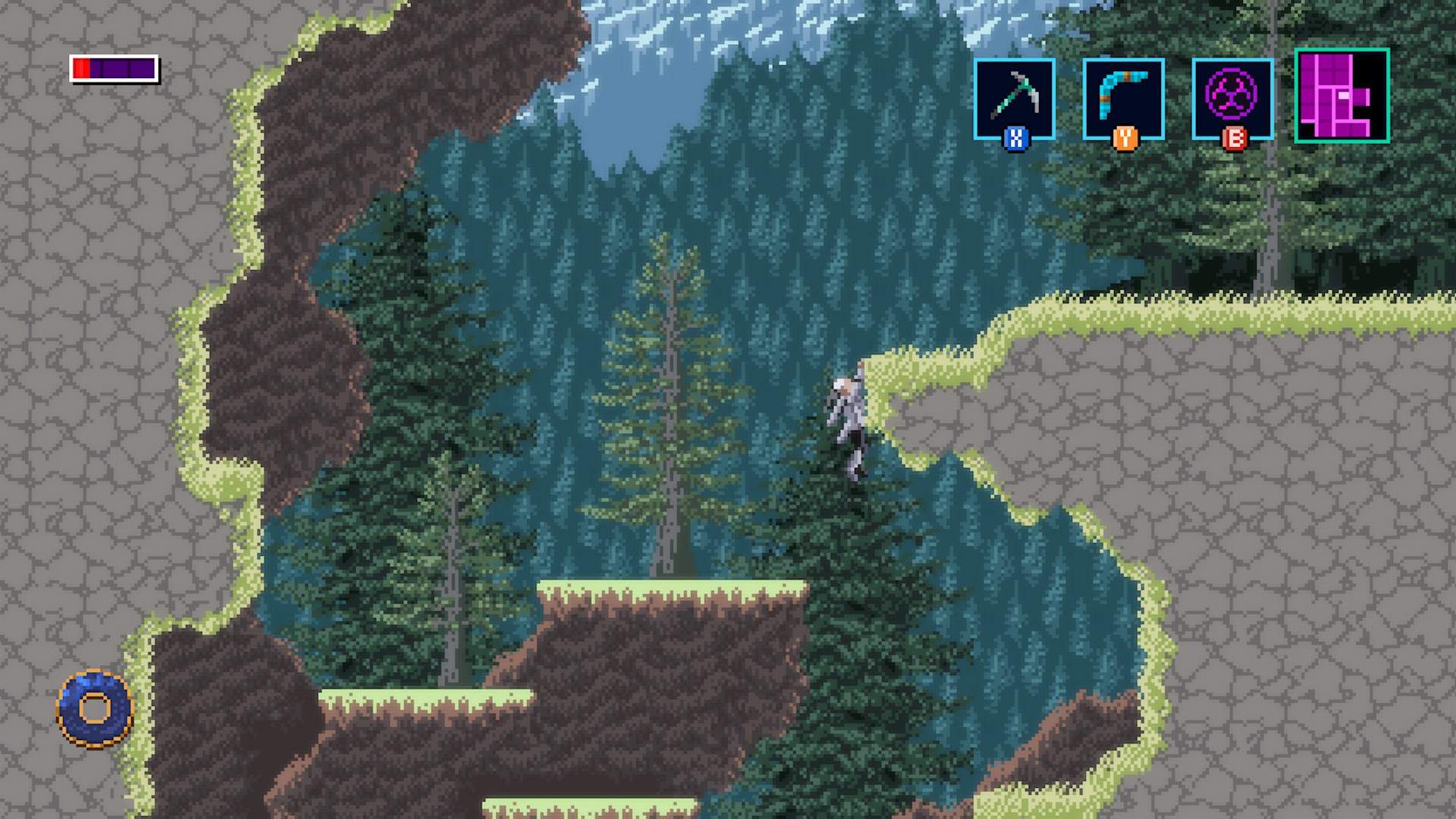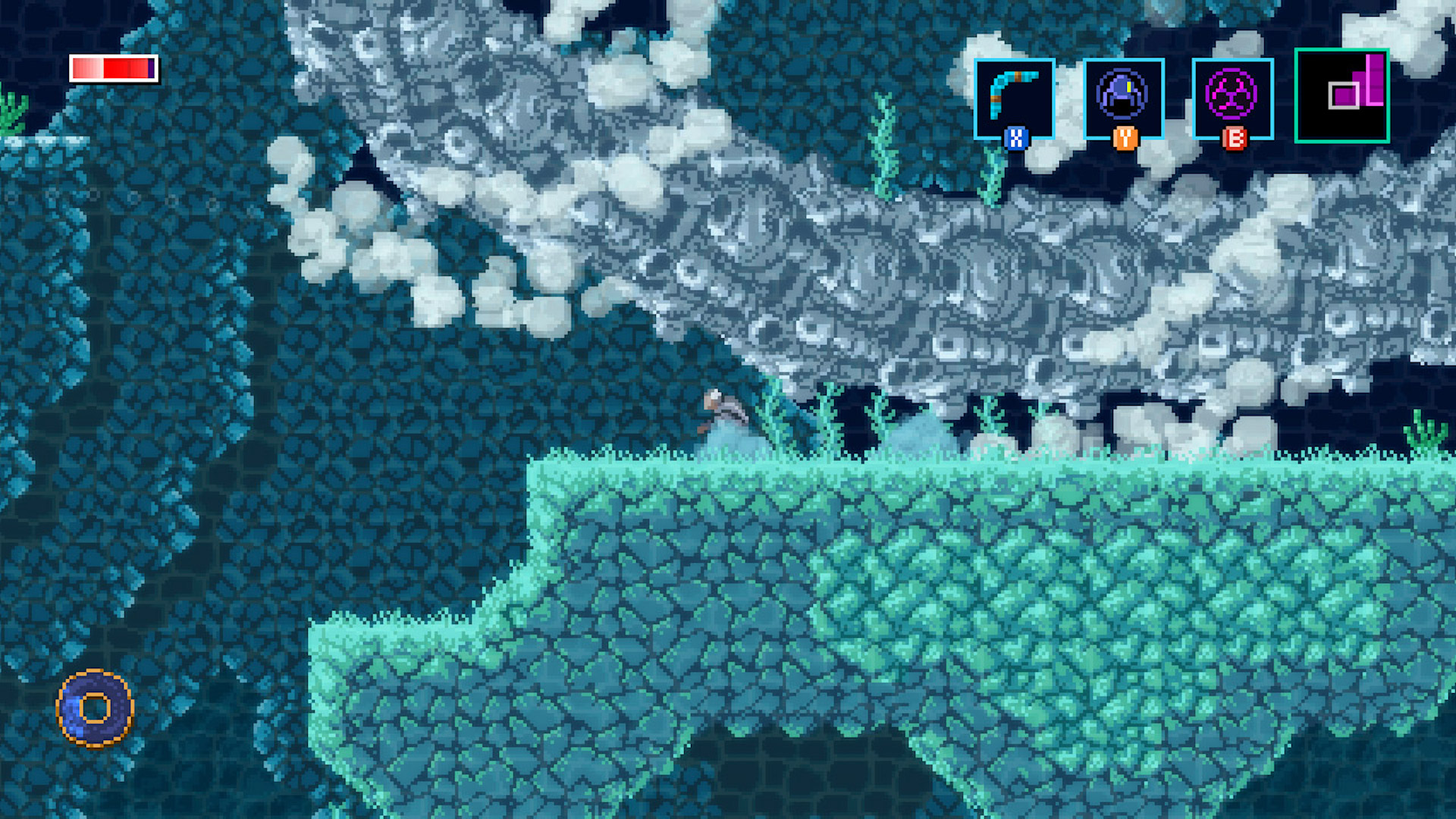Following up on the original Axiom Verge isn’t an easy ask. The original title is one of those rare indie games that won rave acclaim for delivering on their premise through and through. Axiom Verge 2 manages to ultimately be a worthy follow up to the first game by not really concerning itself as much with what that title did, and instead by squarely emphasizing its own identity, doing its own thing, and delivering a distinct but accomplished take on the Metroidvania conceit in the process.
The differences between Axiom Verge 2 and its predecessor, and indeed, between it and many other games of this format, are apparently almost right away. You’re playing in organic outdoor environments a lot of the time, rather than the claustrophobic indoors that so many games of this genre make their haunts. It also ends up de-emphasizing combat drastically. Your weapons now are a melee pickaxe and a boomerang you can use at range, and while you get both of these pretty early, you also end up realizing equally early that combat is really not the point of this game. Exploration and traversal are. In fact, Axiom Verge 2 is so committed to deemphasizing combat that even the bosses are entirely optional. They’re there, and beating them nets you some cool upgrades you can then choose to grow Indira – but they can be entirely avoided should you be so inclined.
"Axiom Verge 2 manages to ultimately be a worthy follow up to the first game by not really concerning itself as much with what that title did, and instead by squarely emphasizing its own identity, doing its own thing, and delivering a distinct but accomplished take on the Metroidvania conceit in the process."
Making bosses optional is just one part of the concessions to accessibility and accommodating players of all persuasions that Axiom Verge 2 makes. There are also extremely granular settings to control the game’s difficulty, from being able to control exactly how much damage your hits do to enemies, to how much damage enemies do to you. Axiom Verge 2 gives you the tools to define the experience and the challenge it presents to you – if you want to enemies to be able to knock you out in one hit, then Axiom Verge 2 lets you do that. If you would rather be able to export the world without having to worry about dying and backtracking to lose progress, Axiom Verge 2 does that too. It’s a remarkably well balanced and well-tuned game across all the various permutations and combinations for difficulty and challenge that it provides, which means no matter how you play, you’re never getting a neutered experience.
Axiom Verge 2 makes other concessions to modern game design too. On paper, you would assume these concessions could threaten to dilute the entire appeal of a Metroidvania game. For example, you always have a marker on your map showing you where to go, you always have a compass pointing you in the general right direction. You even end up unlocking a fast travel system that almost entirely takes the tedium out of backtracking. And it is true that on a macro scale, these kinds of systems and mechanics do take away from the world seeming as sprawling or unknowable as something like Ori or Hollow Knight might. But Axiom Verge 2 is a very smartly designed game, and within each area, it maintains multiple micro loops of Metroidvania style progression and traversal, with each area essentially being a self-contained Metroidvania world, full of shortcuts and barriers that are only unlocked to give you access to newer areas and such once you gain the powers hidden in that area.
These micro loops of Metroidvania progression end up doing a wonderful job of recreating the highs of exploring and uncovering a world, while also never getting so daunting that they threaten to make a player lose their bearings entirely. You always know what direction to head in. You know that your exact location can be called up at any time. You even have the assurance of knowing that nothing in the world can hurt you more than you want to be hurt – this ends up freeing you up from the stresses that a Metroidvania game can otherwise typically bring, and allows you to truly immerse yourself in the world and explore it bit by bit.
"These micro loops of Metroidvania progression end up doing a wonderful job of recreating the highs of exploring and uncovering a world, while also never getting so daunting that they threaten to make a player lose their bearings entirely. You always know what direction to head in."
And it is a world worth exploring. I mentioned those organic outdoor environments before, but even within the context of that aesthetic, it’s remarkable how varied Axiom Verge 2 gets with its world, from glaciers to deserts, forests to caves, mountains to waterfalls, and beyond. The world itself is inextricably tied to the story and lore, and the more you play, the more you learn, whether via the chatter from the occasional NPC you stumble upon, or the various notes and journal entries that are scattered around the world, and which slowly reveal exactly what is going on around you, raising a whole lot of narrative and philosophical questions that can and should give any player pause.
This emphasis on narrative is another way that Axiom Verge 2 stands apart from most other games of its ilk. Metroidvania games, are topically fairly light on storytelling. Oh sure, there’s loads of lore and backstory and even environmental and atmospheric storytelling going on in each of those, to be clear – but direct storytelling is not something they do often. Which makes sense, the more story you have, the less freedom, by definition, a player ends up having, and a Metroidvania game that doesn’t give its players freedom is no Metroidvania at all.
Axiom Verge 2, as mentioned, smartly sidesteps this issue with the whole micro Metroidvania loops. While it is true that your general direction and next objective is always known to you, the game also doesn’t really mind letting you go off on your own and get lost, and it also rewards the enterprising player who does decide to explore the world on their own time.
But a narrative focus isn’t the only way Axiom Verge 2 sets itself apart from other games in the genre – one of the coolest things in the game is the ability that the protagonist Indira ends up getting, the ability to hack into enemies and machines around her, which, again, can provide a bevy of ways for players to deal with hostile characters without engaging in direct combat. You can disable enemies, or simply move them out of the way, or of course, you can hack them to turn them into allies, and let them do your dirty work for you (or assist you in yours).
"A narrative focus isn’t the only way Axiom Verge 2 sets itself apart from other games in the genre – one of the coolest things in the game is the ability that the protagonist Indira ends up getting, the ability to hack into enemies and machines around her, which, again, can provide a bevy of ways for players to deal with hostile characters without engaging in direct combat."
Indira also gains the ability to spawn remote controlled drones, who can go into areas she can’t go into, navigating and nullifying obstacles that would otherwise keep you from progressing. This includes the drone’s ability to enter an alternate dimension known as the breach, which can allow your drone to get to places it is otherwise physically impossible to get to in the real world, and therefore end up creating a path for you to follow. The breach, combined with the game’s non-linearity as mentioned before, ends up basically blowing the map wide open, and loads to Axiom Verge 2’s world feeling like one gigantic traversal puzzle – something the best Metroidvania games achieve, though of course, they end up going about it in very different ways.
All of this leads to a smartly designed and incredibly satisfying game, and one that’s entirely different from most other games of this genre. Axiom Verge 2 does stumble, to be clear – the bosses, deemphasized as they are, are rather straightforward encounters, lacking the panache and thrill that they might have in other similar games, for example, the combat feels less satisfying than in other games of the genre, and the broader world design does lack that sense of labyrinthine progression that marks the best Metroidvania games. If you come into this looking for the sort of dizzying heights of world design that you can find in Hollow Knight, you’re not going to find them here. Depending on exactly what you look for from your Metroidvania games, you might even be outright disappointed in fact. This is a very different kind of Metroidvania title – the bulk of its Metroidvania progression is maintained in smaller doses, and the broader game is defined by a surprising narrative focus.
But Axiom Verge 2 is trying to do its own thing. It’s expanding the definition of a Metroidvania game, honestly, and the fact that we have a game that’s as non-linear and expansive as this, while still being as narrative driven as this, while still delivering the Metroidvania progression so many players love, makes it truly a great accomplishment in game design. The various things it tries – the story focus, the non-linear exploration, bringing in the breach, the deemphasizing of the combat, the new setting, the accessibility considerations, all of it – they end up delivering a very unique experience that is still, at its heart, a Metroidvania game, and equally important, an Axiom Verge sequel, through and through. If you’re looking for something different from the usual Metroidvania game? Axiom Verge 2 is the best place to start.
This game was reviewed on the Nintendo Switch.
from Video Game News, Reviews, Walkthroughs And Guides | GamingBolt https://gamingbolt.com/axiom-verge-2-review-into-the-breach
 Reviewed by makinet
on
August 20, 2021
Rating:
Reviewed by makinet
on
August 20, 2021
Rating:



No comments: